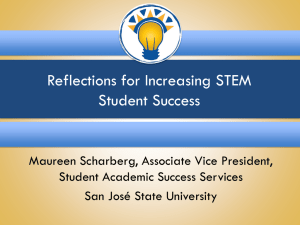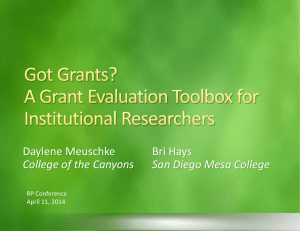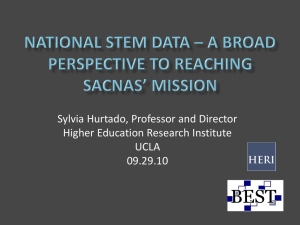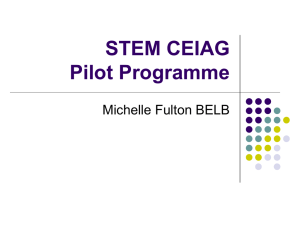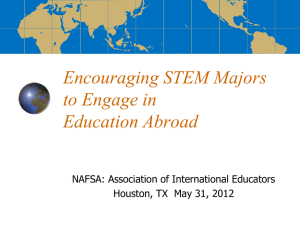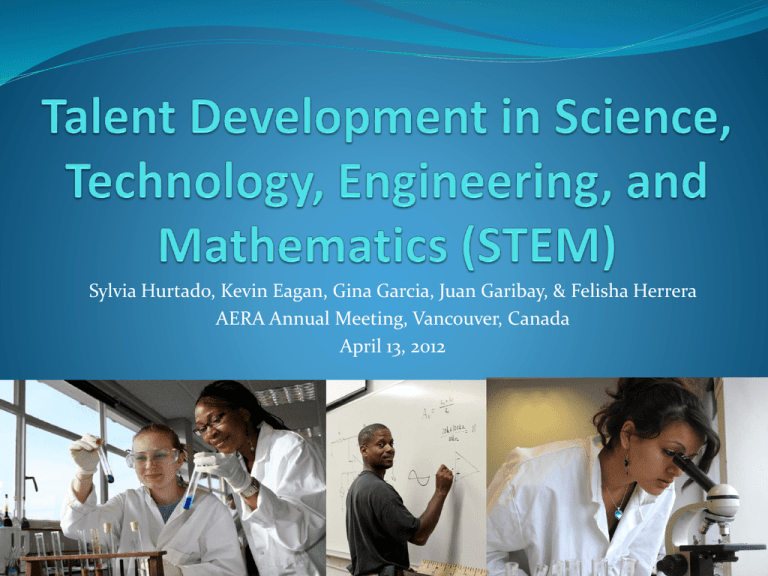
Sylvia Hurtado, Kevin Eagan, Gina Garcia, Juan Garibay, & Felisha Herrera
AERA Annual Meeting, Vancouver, Canada
April 13, 2012
Overview of Symposium
Introduction to Topic
Paper #1: Passing Through the Gates: Identifying and
Developing Talent in Introductory STEM Courses
Paper #2: Accentuating Advantage: Developing
Science Identity During College
Paper #3: A Model for Redefining STEM through
Identity: Insights from the Educational Trajectories of
Talented STEM Graduate Students
Implications & Conclusions
Introduction
The symbiotic connections of an ecosystem and
survival of the fittest.
We explore the interdependences of context, student
and the role of faculty that result in talent
development, while at the same time, the same
elements are involved in sorting to limit the
production of scientists.
Background
STEM attrition in the first two years of college
Low grades and un-engaging pedagogy are just some
of the obstacles students encounter
Success and talent
Measured by grades
Determined by prior achievement and study skills
Purpose
To explore alternative measures of talent (beyond
grades) in introductory STEM courses
To determine how talent is developed and harvested
within introductory STEM courses
To examine how “thinking” and “acting” like a scientist
contributes to success in STEM courses
Sequential, Explanatory
Mixed Methods Design
Collected, analyzed, and integrated both quantitative
and qualitative data during the research process
Quantitative data collected first; informed selection of
institutional sites for qualitative data collection
Data fully integrated during the analysis
Quantitative data provided a broad picture of
students’ engagement
Qualitative data more deeply explored student views
regarding their introductory classroom experience
Connecting
Quantitative
& Qualitative
Phases
QUANTITATIVE
Data Analysis
QUANTITATIVE
Data Collection
Integrating
Quantitative &
Qualitative
Results
Qualitative Data
Collection
Qualitative Data
Analysis
Quantitative Methodology
Four data sources
Pre- and post-survey for students in introductory course
One-time survey for faculty teaching introductory course
Registrar’s data
Sample
15 colleges and universities
73 introductory STEM courses
2,873 students
52% White
61% Women
42% aspired to earn a medical degree
21% aspired to earn a Ph.D. or an Ed.D.
75% reported majoring in a STEM discipline.
Quantitative Methodology
Three outcome variables
Final grade in introductory course
Acting like a scientist (latent)
Thinking like a scientist (latent)
Predictor variables
Demographic characteristics
Pre-college preparation
Experiences in introductory STEM courses
Pedagogical techniques used in introductory STEM
courses
Quantitative Methodology
Weighted data to adjust for non-response bias
Missing values analysis
Confirmatory factor analysis
Multilevel structural equation modeling (SEM)
Qualitative Methodology
Eight sites
1 HBCU, 1HSI, 6 PWIs
Two data sources
Students: 41 focus groups (n = 241 students)
54% White
21% Asian/Asian America
14% African American
8% Latino
3% Native American
62% Women
Faculty: 25 in-depth interviews with faculty
Chemistry, biology , mathematics, & engineering
Qualitative Methodology
Semi-structured interview protocol
Experiences in introductory STEM courses, motivation,
course structure, learning, instruction, & assessment
Goals and objectives for introductory STEM courses,
pedagogical approaches, structure, forms of assessment,
& institutional support for teaching
Emergent code development
Open coded in NVivo8
Inter-rater reliability: 80-85%
Re-validated coding architecture
Linked codes to participant attributes
Alternative Ways to Identify Talent
I like the questions they ask, so for the vert bio I'll be
lecturing long and I'll ask a little question here and there
that might be pointed. You know, like, “how do you think
the sharks ventilate if they're not doing this buccal
pumping kind of thing, cuz they don‘t have the
operculum?” I'll get them to, I answer questions in class
just to make sure [they're] kinda tracking me or thinking
about stuff. But then the ones that I'm like, whew, you're
really good, [ask], "Okay, you've told me about how they
change their osmoregulation when they go from fresh
water to salt water. How exactly does that happen, and
how does it happen on the way back?” (Professor
Veerdansky, Western Private Master’s College)
Direct Effects: Final Grade
Predictor
Confidence in ability to learn
Composite SAT
HS Biology Grade
I felt my hard work was reflected in my grades
I considered dropping the course
I was well-prepared for course
Self-rated time management
Changed study habits during term
Classroom Level: Professor used essay exam
β
0.06
0.19
0.15
0.14
-0.26
0.09
0.13
-0.14
-0.39
Sig
***
***
***
***
***
***
***
**
Grades Do Not Matter
Yeah. I had a student…he got [a] B plus, but he would
solve problems that nobody could solve. He wouldn’t
be able to solve the problems that everybody could
solve, but he solved the problems that no one could.
Now, that was very impressive, but he didn’t do well on
the exams…he actually did very well later on.
(Professor Pace, Western Public Research University)
Direct Effects:
Acting Like a Scientist
Predictor
Pre-test: Acting like a scientist
Pre-test: Thinking like a scientist
Confidence in ability to learn
Course emphasizes applying concepts to new
situations
I was well-prepared for course
Changed study habits during term
Attended review sessions
Classroom level: Professor dispelled
perceptions of competition
β
0.41
0.11
0.16
0.11
Sig
***
***
***
***
0.06
**
0.04
**
0.08
***
0.59
*
Acting Like a Scientist
Well, like how the labs really supplement the class, like
they really make you think about the main concepts,
about like how you would apply it to like real life or
what you would actually do that shows this process of
whatever. The really helps you kind of think about it
other than just like bullet points on a piece of paper, so
that really helps.
(Marissa, Southeastern Private Master’s College)
Direct Effects:
Thinking Like a Scientist
Predictor
β
Sig
Pre-test: Acting like a scientist
0.11
***
Pre-test: Thinking like a scientist
0.38
***
Confidence in ability to learn
0.22
***
Course emphasizes applying concepts to new
situations
0.07
***
I considered dropping the course
-0.04
*
I was well-prepared for course
0.06
**
Race: White
0.04
**
Attended review sessions
0.10
***
Classroom level: No question is too elementary 0.57
*
Thinking Like a Scientist
Well, I took Basic Chemistry last year, and I’m taking
General Chemistry, which is the next step above it, and
I feel like I was really prepared for it. ‘Cuz right now
I’m in Gen Chem [and] like, I already know this, yeah?
Like, I guess the professor who taught me was good at
what she was doing ‘cuz I already knew what I was
doing and like, right now some kids are already
confused about like, the stuff we learned last year.
And we were supposed to know this already, but I
guess they were confused because of the professor.
But for me it was kind of a breeze.
(Sameer, Southwestern Public Research University)
Discussion
Grades useful for sorting talent but not for capturing
gains in dispositions for scientific work
Necessary to broaden performance criteria
Change pedagogical styles to allow students to apply
concepts to encourage thinking like scientist
Reframe introductory STEM courses to focus on
higher-order thinking rather than merely transmission
of knowledge
Kevin Eagan, Sylvia Hurtado, Juan Garibay, & Felisha Herrera
Background
Early commitment to STEM can have lasting effects on
STEM persistence.
Call to identify practices that promote stronger STEM
identity given high attrition rates in STEM.
Strong STEM identity:
Improves STEM retention (Chang et al., 2011)
Shapes trajectories within STEM disciplines (Carlone &
Johnson, 2007)
Purpose
To examine how students’ experiences at various
time points and across institutional contexts help
shape the development of students’ science
identity during college.
STEM Identity
Competence, Performance, & Recognition*
STEM identity is a negotiated self, constantly under
construction
STEM identity is shaped by*^:
Individual’s own assertions
External ascriptions
Experiences in STEM
*(Carlone & Johnson, 2007)
^(Martin, 2007)
Influences on STEM Identity
Early learning experiences (Tran et al., 2011)
Number of high school STEM courses (Russell & Atwater, 2005)
Pre-college research experiences (Tran et al., 2011)
Agents
Faculty & Peers (Carlone & Johnson; Martin, 2007)
Parents (Tran et al, 2011)
Self-efficacy (Carlone & Johnson; Hurtado et al., 2009)
College Experiences
Undergrad Research Programs (Hurtado et al., 2009)
STEM Culture (Seymour & Hewitt, 1997)
Theoretical Frameworks
Cumulative Advantage (Allison & Stewart, 1972; Cole &
Cole, 1973; Merton, 1973)
To examine patterns of inequality across time
Accentuation Effects (Feldman & Newcomb, 1969)
To acknowledge and comprehend how predispositions
are accentuated during college
Quantitative Methodology
Data Sources:
2004 CIRP Freshman Survey
Black
19%
2005 CIRP Your First College
Year Survey
2008 CIRP College Senior
Survey
Sample:
1,133 aspiring STEM majors
137 institutions
Analysis:
Structural Equation Modeling
(SEM)
MPlus Software
White
42%
Asian
American
13%
Latino
21%
American
Indian
5%
**CFI= 0.93, RMSEA=0.03
Direct Effects: Predicting Changes in
STEM Identity
STEM Identity 2004
β(sig)
Sex: Female
-0.07 (*)
Pre-college Summer Research Prog
0.13 (***)
Years of Biology in High School
0.17 (***)
College Reason: Prepare for Grad School
0.37 (***)
***p<0.001, **p<0.01, *p<0.05
Direct Effects: Predicting Changes in
STEM Identity
STEM Identity 2005
STEM Identity 2004
β(sig)
0.72(***)
Pre-professional/departmental club
0.06(*)
Worked on Professor’s Research Proj
0.10(**)
Freq: Faculty Interaction (Office Hours ‘04/05)
0.09(**)
Success adjusting to college academic demands
0.08(**)
Self-rating: Math ability 2005
0.11(***)
Changed to Non-STEM major in ‘04/05 year
-0.15(***)
***p<0.001, **p<0.01, *p<0.05
Direct Effects: Predicting Changes in
STEM Identity
STEM Identity 2008
β(sig)
STEM Identity 2004
0.25(**)
STEM Identity 2005
0.36(***)
Structured research program during college
0.11 (***)
Persisted in STEM through 2008
0.15(***)
Worked on professor’s research project
0.17(***)
Faculty encouragement to pursue grad school
0.14(***)
Institutional Selectivity
-0.09(**)
Self-rating: Math ability 2008
Self-rating: Math ability 2005
0.41(***)
Self-rating: Math ability 2004
0.30(***)
***p<0.001, **p<0.01, *p<0.05
Indirect Effects: Predicting Changes in
STEM Identity
STEM Identity 2005
β(sig)
Sex: Female
-0.05(*)
Years of Biology in High School
0.13(***)
Pre-college Summer Research Program
0.09 (***)
College Reason: Prepare for Grad School
0.26(***)
***p<0.001, **p<0.01, *p<0.05
Indirect Effects: Predicting Changes in
STEM Identity
STEM Identity 2008
Years of biology in high school
β(sig)
0.04(*)
Decided to pursue non-STEM major in ‘04/05
-0.05(**)
STEM Identity 2004
0.26(***)
Pre-college summer research program
0.03(**)
College Reason: Prepare for graduate school
0.09(***)
Freq: Faculty Interaction (office hours) ‘04/05
0.03(*)
Success adjusting to college academic demands
0.03(*)
Worked on professor’s research project
0.04(*)
***p<0.001, **p<0.01, *p<0.05
Discussion
Cumulative Advantage
Students who have access to stronger preparation/resources enter
college w/ stronger STEM identities.
These students appear more likely to continue to access in college
these critical resources that further strengthen their STEM
identities.
Accentuation Effects
Initial STEM identities are accentuated during college as students
tend to participate in activities that value and nurture their STEM
identities.
Find peers with mutual interests
Identify early opportunities for strengthening their STEM ID
Implications
Importance of understanding inequality in STEM
identity development
Importance of early experiences:
With research
Support networks w/ peers and faculty
Early contact with & receiving recognition from faculty
Stronger high school preparation
Felisha A. Herrera
Sylvia Hurtado
Gina A. Garcia
Josephine Gasiewski
Introduction
Underrepresented Racial Minority (URM) students
aspire to major in STEM at the same proportional rates
as their White and Asian American peers
URM students earn only 17% of STEM bachelor
degrees
Several scholars have utilized the construct of identity
to understand students’ STEM pathways and the
recruitment or alienation of URM students in STEM
Science Identity
Carlone & Johnson, 2007)
Competence
Performance
Recognition
Influence of Racial, Ethnic,
& Gender Identities
STEM Identity
Intersectionality lens
STEM Identity merged with social identities
Adapted from Jones & McEwen (2000), “Multiple dimensions of identity” and Carlone & Johnson (2007), “Science Identity
Contexts &
Opportunities for Recognition
Structures within contexts
“the patterns that characterize, facilitate and constrain groups and
societies, including social norms, social roles, and the conformity
pressures that individuals may experience within groups”
STEM disciplines/contexts
Racial/ethnic community contexts
Race/
Ethnicity
Religion/
Spirituality
Mental/Physical
Ability
Social
Identities
Nationality/
Immigration Status
Socioeconomic
Status
Gender
Culture
Groups/Communities
Sel
f
Sexual
Orientation
Racial/Ethnic
Communities
Groups/Communities
Recognition of Talent
Invisible strategies developed through perseverance
despite facing structural inequities
I came from a very low-income family so the kind of
resources I have available to me and throughout college
and even now is very different from that of other people
and that’s always been very salient to me. It’s just the
different sorts of resources I had available to me and the
kinds of things I reference. This taught to take full
advantage of every resource that I could get my hands on.
(Sophia, Latina, Epidemiology)
Recognition of Racial/Ethnic
Community Cultural Knowledge
Cultural knowledge: a currency students use to make
meaning
“When is science?” Racial/ethnic communities as contexts
where science occurs
I was raised in a small farming community. So my family has
always had the same interest in agriculture. They have farmer’s
knowledge from what their parents taught them and what their
parents taught them…that has a strong background in sciences
(Mason, Latino, Environmental Science)
Recognition of Racial/Ethnic
Community Networks
Broad cultural networks as opportunities for
interactions with diverse communities
My first advisor actually was pretty awful, but now I
have a good advisor that’s invested in my
[participation] in the things that are important to me
like teaching Indian students and going to these
conferences to meet other Indian people and network
so I can get a job teaching and working in science with
Indians (Carson, American Indian, Bioinformatics)
Implications
Practical Implications
Acknowledging the historically oppressive contexts
Highlighting significant ethnic minority figures in
STEM
Surfacing the historical and cultural context of STEM
research
Different ways of knowing used around the world
Implications for Research
Identity lens for a deeper understanding of URM
pathways in STEM
Framing of the benefits for increasing representation in
STEM
Overall Conclusions
Context matters
Early exposure to research
Prime and cultivate students’ interest in STEM early in
college
Contact Info
Faculty/Co-PIs:
Sylvia Hurtado
Mitchell Chang
Postdoctoral Scholars:
Kevin Eagan
Josephine Gasiewski
Administrative
Staff:
Dominique
Harrison
Graduate Research Assistants:
Tanya Figueroa
Gina Garcia
Juan Garibay
Felisha Herrera
Bryce Hughes
Cindy Mosqueda
Papers and reports are available for download from project website:
http://heri.ucla.edu/nih
Project e-mail: herinih@ucla.edu
This study was made possible by the support of the National Institute of General Medical Sciences, NIH Grant Numbers 1 R01
GMO71968-01 and R01 GMO71968-05, the National Science Foundation, NSF Grant Number 0757076, and the American Recovery
and Reinvestment Act of 2009 through the National Institute of General Medical Sciences, NIH Grant 1RC1GM090776-01. This
independent research and the views expressed here do not indicate endorsement by the sponsors.

